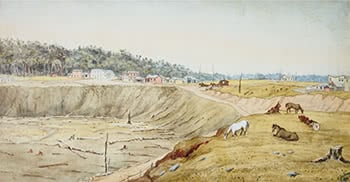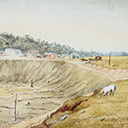Eketahuna
35 x 66 cm
Eketahuna, as a European settlement, owes its origins to Sir Julius Vogel's Immigration and Public Works Act of 1870 which initiated a new wave of colonisation. Some 7,500 new arrivals, the majority from Scandinavia, landed in New Zealand by the middle of 1873. Vogel's scheme was essentially to open up the hinterland of the country by the clearing of the bush, and the building of new roads, bridges and railways.
The settlers called their new home Mellemskov which means, Heart of the Forest and maps of the 1870s give this name for the settlement. However, by the end of the seventies the name had reverted to the Maori one of Eketahuna which means, to run aground on a sandbank; so named by the 'tangata whenua' to describe that location where their waka or canoes could travel no further up the Makakahi River, which bisects the township.





